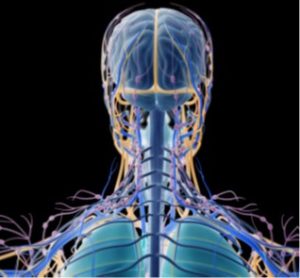The Importance of the Glymphatic System – part one
Written by Emma Lane
In February 2021 I wrote a blog about the importance of the lymphatic system for health and the extent to which lymphatics are still very much under recognised for their far-reaching health effects. In that article I very briefly mentioned the glymphatic system and it seems very relevant to understand the importance of supporting your neuro-lymphatic system known as- the glymphatic system too.
THE LYMPHATIC SYSTEM IN THE BRAIN
Until 2015, we believed that the lymphatic system did not extend to the brain. The brain was considered an “immune-privileged” area of the body, and scientists puzzled over how waste products were cleared from the nervous system. In fact, accounts of brain lymphatics exist from over 200 years ago in the work of Italian anatomist Paolo Mascagni’s publication on the lymphatic system. And more recently, studies from 1948 to 1996 explored and described lymphatic function in the meninges area of the brain, specifically the dura mater.
This information was overlooked until 2015, when two un-associated labs published rodent studies showing evidence of lymphatic anatomy and action in the brain. Now, the rediscovered neuro-lymphatic system is being studied for its role in neurodegenerative diseases such as dementia and Alzheimer’s disease, along with our ability to learn, sleep and adjust to stress.
The function of the glymphatic and lymphatic systems are interconnected; the lymphatic system dominates fluid movement throughout the day and the glymphatic system takes over at night. This glymphatic-lymphatic tag team helps clear the dementia-associated protein amyloid-beta, as well as other proteins that may contribute to neurodegenerative diseases.
SO, WHAT DOES THE GLYMPHATIC SYSTEM DO?
Simply cerebrospinal fluid and the brain’s immune system make up the glymphatic system which filters out waste and harmful metabolites that play a role in disorders that affect the brain. The researchers at the University of Rochester tracked the flow of fluid (cerebrospinal fluid) between brain cells and through the central nervous system and found that brain cells contract, finding that the space between the cells increased from 14% of brain volume to 23%.
This translates into a 60% increase in space between the cells. At night when we sleep this space plays a key role as it allows the cells to be bathed in larger amounts of cleansing fluid than during waking hours. When the brain is not able to clear out waste, it accumulates in the brain. This waste is toxic, and can instigate mechanisms like inflammation and cell death.
TOXIC BUILD UP IN THE BRAIN
Every single day we are exposed to a number of toxins in our daily environment. Every toxin that is in the environment will eventually be in our bodies. Neurotoxins are toxins that specifically target the nerves in our bodies. Once they reach their target they attack, and this is one of the biggest contributors to neurological disease.
Nerves are not just electric wires; they serve a number of vital purposes. One of these is axonal transport, a system that moves nutrients from the brain to the cells. The neurotoxins use this transport system to travel into cells and do damage. Symptoms of neurological diseases, like brain fog and impaired memory, can start presenting almost immediately after the cells have been attacked by these toxins.
A few of the more prevalent toxins in our environment include metals such as mercury, aluminium, lead, petrochemicals and pesticides. Many toxins are bioaccumulating in our bodies, and there is evidence that all of these toxins contribute to the deterioration of brain health in various ways. While there’s no way to completely avoid them, there are things you can do to support and protect your brain, I will discuss these later.
Your glymphatic system is a very important waste clearance system for your brain. Our brain uses this system to drain the toxins away while we sleep. Each night, during deep sleep, the brain shrinks and gets washed with cerebrospinal fluid, and this waste is carried through the glymphatic system and gets moved into the peripheral lymph.
While this is happening, the system is also bringing nutrients to neurons and removing toxicity out of the brain. This system is how our body keeps neurological degeneration and disease at bay, and is one of the most underappreciated but vital systems in our bodies. It is also a system that is delicate, easily injured and upset.
A common way to incite problems in the glymphatic system is to have experienced brain injuries from car accidents, sports such as football, rugby and gymnastics where participants experienced concussions. However, unfortunately today you are much more likely to suffer injury to your glymphatic system through daily lifestyle choices such as improper sleeping habits and technology disrupting our sleep patterns.
It is also incredibly important to support proper glymphatic drainage. The less congested the cervical lymph nodes and the entire lymphatic system (see the previous article for guidance on creating better lymph drainage) the better able the glymphatic system will be to drain and protect the brain against environmental exposures. When your system is overloaded with toxins that are only building and not draining properly, the glymphatic system becomes compromised. There is only so much that can be done before the system is overwhelmed, and the toxins begin to attack your brain.

EASY DAILY CHOICES TO SUPPORT YOUR BRAIN HEALTH
Rehydrate and move
Your brain shrinks over 60% every single night when you sleep. The brain shrinks to help the glymphatic system move toxins out, therefore you have to help the brain fill back up with healthy fluids. You can do this by drinking a large glass of filtered water with electrolytes to promote hydration as soon as you wake up.
Not only is this vital to your glymphatic system and brain health, but you will also find yourself more awake and alert every morning. Fill a large glass or water bottle in the evening, and put it next to your bed so that you will be reminded to drink first thing in the morning.
It was thought that the glymphatic system was only effective at night during sleep and was the only way to flush toxins from the brain, however a new study shows that exercise can positively affect the function of the glymphatic system. In this study, one group of mice had access to a running wheel, the other group of mice had no access to exercise. After five weeks, the group of mice that had access to exercise showed a more than two-fold increase in glymphatic flow.
Therefore, moving regularly through the day is wise and remember movement also supports overall lymphatic activity so whether it is yoga, bouncing on a rebounder, walking, running, gardening or any other form of movement, it can help to increase glymphatic flow and support brain health.

SLEEP HYGIENE
Although movement supports glymphatic flow, the glymphatic system doesn’t get activated until you are asleep. Therefore, great flow doesn’t help your brain UNLESS it is paired with sleep.
The recommended amount of sleep for an adult is 7 to 9 hours. Our brain needs to be in a state of deep sleep for our glymphatic system to work.
It may feel like we do nothing while we sleep, however our bodies are working in overdrive to heal and maintain function. When you don’t get enough sleep the glymphatic flow is interrupted and toxins and infections can accumulate in the brain and lead to neural degenerative diseases or other brain symptoms.
Its well-known now that sitting for extended periods of time has very negative health effects. What many people do not realise is that sleeping on a flat surface has just as many negative impacts on your health! Interestingly most mammals choose to sleep with their heads uphill, Dr. Günther W. Amann-Jennson noted that “wild animals and domestic livestock all have a natural preference for sleeping on the ground with their heads slightly uphill.” with us humans there is no reason or logic as to why we sleep on a flat surface.
Gravity inclined sleeping is much better for us! Many of the beds created for Egyptian royalty were crafted with a roughly five-degree incline.
Gravity inclined sleeping is exactly what it sounds like. Instead of sleeping on a flat surface, the bed is at a slight incline of 3.5 to 5 degrees. The main benefit with Gravity inclined sleeping is improved circulation of blood and lymph, simply by gravity. When you sleep, your brain detoxifies itself through the glymphatic system. Adding a 3.5-5-degree incline to your sleeping surface can greatly help the glymphatic system drain “downhill” to the gut to be excreted. This can help detoxify heavy metals, pathogens, and other harmful substances from the brain.
Disordered breathing during sleep
Snoring and obstructive sleep apnoea are major risk factors for many diseases due to a lack of oxygen during sleep. Sleeping on an incline helps to open the airway, alleviating snoring and restoring oxygen to the brain. The force of gravity from sleeping inclined also prevents acid reflux and heartburn.
What can I use to elevate the head of my bed?
Most adjustable beds bend in the middle so that the top half rises and the lower half stays horizontal. With incline sleep the goal is to maintain a flatbed surface while creating a slope from the head-of-the bed downward to the food of the bed.
Folding just the head of the bed up with an adjustable bed frame will not work, the entire bed has to be on a slope. For a standard bed, this works out to adding roughly 5-6 inches of height to the head of the bed. Adding 3 inches of support to the middle of the bed frame may also be needed for stability. You can buy 3- and 6-inch risers online, or use books, bricks, or wood. Alternatively, Mattress Elevator – Made with CertiPUR foam, these wedges slide under the whole mattress so that it slopes gently.
Sleeping on an incline may feel weird at first, although some people adjust with ease because it is only a modest incline. Some people may need to start with just a few inches and increase every week or two as they get used to it. Since it does increase detoxification from the brain, taking a toxin binder before bed is recommended. It can take weeks of sleeping on an incline to start noticing improvements.
Side sleeping
Researchers have also found that side sleeping – especially on our right side – increases glymphatic waste clearance when compared to sleeping on your back or stomach. Gravity and intracranial pressure both influences how cerebrospinal fluid and blood move through the brain, and both intracranial pressure and cerebral hemodynamic’s are influenced by body posture. Though some of the exact mechanisms are still being sorted out, it seems that how nerves and veins stretch in each position impacts venous drainage of the carotid veins.
To produce the best results, sleep on the right side, as the pressure gravity exerts pushes toward our chest cavity instead of into our rib cage, which reduces pressure on the heart and optimizes output.


Reference’s
Sandrone S, Moreno-Zambrano D, Kipnis J, et al. A (delayed) history of the brain lymphatic system. NatMed 25, 538–540 (2019). https://doi.org/10.1038/s41591-019-0417-3. Available from: https://www.nature.com/articles/s41591-019-0417-3?proof=t2019-11-4#citeas
Natale G, Limanaqi F, Busceti CL, Mastroiacovo F, Nicoletti F, Puglisi-Allegra S and Fornai F. Glymphaticsystem as a gateway to connect neurodegeneration from periphery to CNS. Front. Neurosci.2021; 15:639140. doi: 10.3389/fnins.2021.639140. Available from: https://www.frontiersin.org/articles/10.3389/fnins.2021.639140/full
He XF, Liu DX, Zhang Q, Liang FY, Dai GY, Zeng JS, Pei Z, Xu GQ, Lan Y. Voluntary Exercise Promotes Glymphatic Clearance of Amyloid Beta and Reduces the Activation of Astrocytes and Microglia in Aged Mice. Front Mol Neurosci. 2017 May 19;10:144. doi: 10.3389/fnmol.2017.00144. PMID: 28579942; PMCID: PMC5437122.
Dissing-Olesen L, Hong S, Stevens B. New brain lymphatic vessels drain old concepts. EBioMedicine. 2015 Aug 14;2(8):776-7. doi: 10.1016/j.ebiom.2015.08.019. PMID: 26425672; PMCID: PMC4563157. Available from: https://www.ncbi.nlm.nih.gov/pmc/articles/PMC4563157/
Stephanie von Holstein-Rathlou, Nicolas Caesar Petersen, Maiken Nedergaard, Voluntary running enhances glymphatic influx in awake behaving, young mice, Neuroscience Letters, Volume 662,2018,Pages 253-258,ISSN 0304-3940,https://doi.org/10.1016/j.neulet.2017.10.035.
Benjamin A. Plog and Maiken Nedergaard, The Glymphatic System in Central Nervous System Health and Disease: Past, Present, and Future. Annual Review of Pathology: Mechanisms of Disease 2018 13:1, 379-394
Sandrone S, Moreno-Zambrano D, Kipnis J, et al. A (delayed) history of the brain lymphatic system. NatMed 25, 538–540 (2019). https://doi.org/10.1038/s41591-019-0417-3. Available from: https://www.nature.com/articles/s41591-019-0417-3?proof=t2019-11-4#citeas
Dissing-Olesen L, Hong S, Stevens B. New brain lymphatic vessels drain old concepts. EBioMedicine.2015 Aug 14;2(8):776-7. doi: 10.1016/j.ebiom.2015.08.019. PMID: 26425672; PMCID: PMC4563157.Available from: https://www.ncbi.nlm.nih.gov/pmc/articles/PMC4563157/
Natale G, Limanaqi F, Busceti CL, Mastroiacovo F, Nicoletti F, Puglisi-Allegra S and Fornai F. Glymphaticsystem as a gateway to connect neurodegeneration from periphery to CNS. Front. Neurosci.2021; 15:639140. doi: 10.3389/fnins.2021.639140. Available from: https://www.frontiersin.org/articles/10.3389/fnins.2021.639140/full
Lee H, Xie L, Yu M, Kang H, Feng T, Deane R, Logan J, Nedergaard M, Benveniste H. The Effect of Body Posture on Brain Glymphatic Transport. J Neurosci. 2015 Aug 5;35(31):11034-44. doi: 10.1523/JNEUROSCI.1625-15.2015. PMID: 26245965; PMCID: PMC4524974.
Levendowski DJ, Gamaldo C, St Louis EK, Ferini-Strambi L, Hamilton JM, Salat D, Westbrook PR, Berka C. Head Position During Sleep: Potential Implications for Patients with Neurodegenerative Disease. J Alzheimers Dis. 2019;67(2):631-638. doi: 10.3233/JAD-180697. PMID: 30614805; PMCID: PMC6398535.
Souza FJFB, Genta PR, de Souza Filho AJ, Wellman A, Lorenzi-Filho G. The influence of head-of-bed elevation in patients with obstructive sleep apnea. Sleep Breath. 2017 Dec;21(4):815-820. doi: 10.1007/s11325-017-1524-3. Epub 2017 Jun 24. PMID: 28647854; PMCID: PMC5700252.
Reddy OC, van der Werf YD. The Sleeping Brain: Harnessing the Power of the Glymphatic System through Lifestyle Choices. Brain Sci. 2020 Nov 17;10(11):868. doi: 10.3390/brainsci10110868. PMID: 33212927; PMCID: PMC7698404.
Silva, I., Silva, J., Ferreira, R. et al. Glymphatic system, AQP4, and their implications in Alzheimer’s disease. Neurol. Res. Pract. 3, 5 (2021). https://doi.org/10.1186/s42466-021-00102-7
Ren H, Luo C, Feng Y, Yao X, Shi Z, Liang F, Kang JX, Wan JB, Pei Z, Su H. Omega-3 polyunsaturated fatty acids promote amyloid-β clearance from the brain through mediating the function of the glymphatic system. FASEB J. 2017 Jan;31(1):282-293. doi: 10.1096/fj.201600896. Epub 2016 Oct 7. PMID: 27789520.
Schmidt C, Xhrouet M, Hamacher M, Delloye E, LeGoff C, Cavalier E, Collette F, Vandewalle G. Light exposure via a head-mounted device suppresses melatonin and improves vigilant attention without affecting cortisol and comfort. Psych J. 2018 Dec;7(4):163-175. doi: 10.1002/pchj.215. Epub 2018 Jun 26. PMID: 29943899.
Chanana P, Kumar A. Possible Involvement of Nitric Oxide Modulatory Mechanisms in the Neuroprotective Effect of Centella asiatica Against Sleep Deprivation Induced Anxiety Like Behaviour, Oxidative Damage and Neuroinflammation. Phytother Res. 2016 Apr;30(4):671-80. doi: 10.1002/ptr.5582. Epub 2016 Feb 5. PMID: 26848139.
Morgan PT, Pace-Schott EF, Mason GF, Forselius E, Fasula M, Valentine GW, Sanacora G. Cortical GABA levels in primary insomnia. Sleep. 2012 Jun 1;35(6):807-14. doi: 10.5665/sleep.1880. PMID: 22654200; PMCID: PMC3353043.